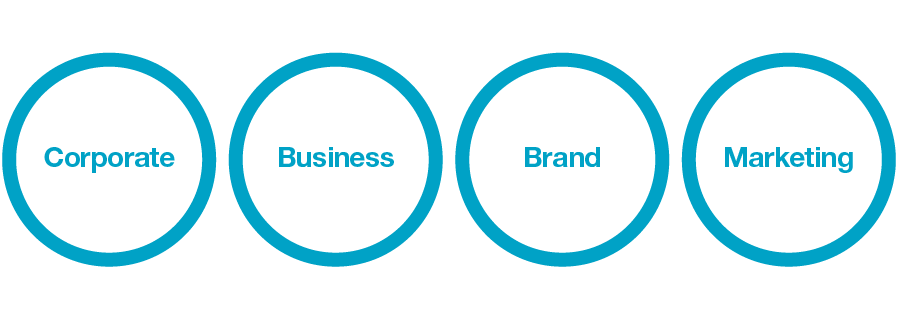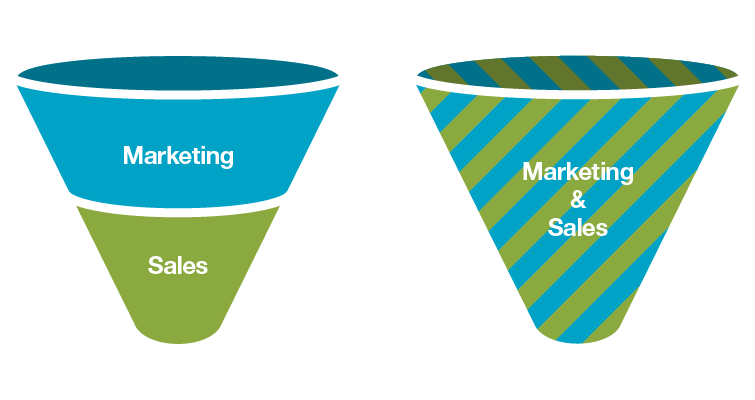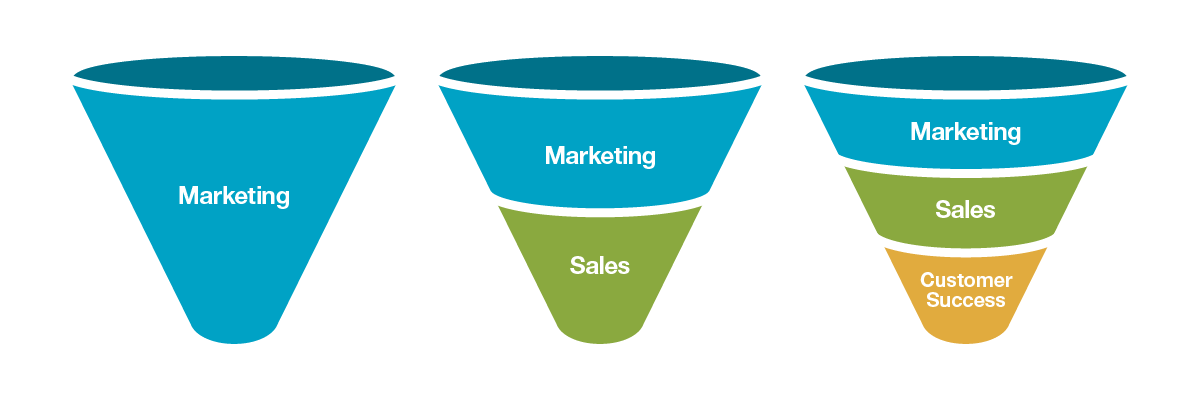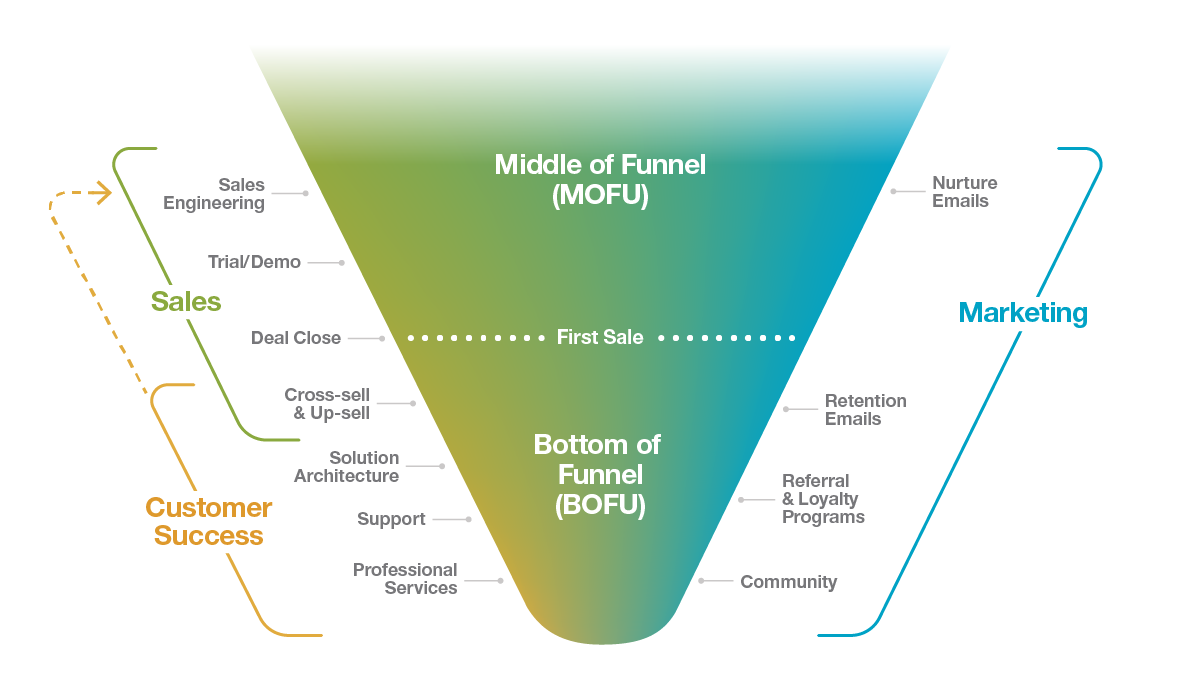For years, I’ve been writing about how businesses can optimize human relationships inside and outside their organizations. I’ve fleshed out this idea over many blog posts, with a core visual denoting three kinds of strategy that should always be tightly linked.
I love the purity of this diagram, but some kinds of businesses merit an expanded framework. In my last post, I complicated this model slightly, by adding a fourth circle for corporate strategy:
For B2B companies, however, there is at least one more circle that’s conspicuously missing, and I want to address it now: Sales.
I have avoided talking about Sales in this series until now for two reasons.
First, many B2C businesses and social sector organizations have no sales functions, so for them, the topic is irrelevant.
Second, it screws up my diagrams.
One but not the same
B2B organizations face an unresolved tension between the business imperative to have a unified distribution strategy that yokes Marketing and Sales together, and the human reality that Marketing and Sales have very different cultures and priorities. The two worlds overlap but don’t cohere, like the cross-hatched cities in the China Miéville novel The City and The City. In other words, each of the following, conflicting, diagrams is correct:
And each of the following funnel illustrations is likewise correct:
This unresolved tension is an example of what Venkat Rao has referred to as an “abstraction leak.” There is in fact no abstraction for the marketing/sales relationship that will work for every situation, industry, or level of scale. Some defining quirk or information will always fail to be captured, and Marketing and Sales will divide yet co-own the funnel no matter what.
Many marketers write about the ambiguity of who owns what, where, across the funnel. Most good textbook models of the customer funnel, for example, look something like this:
Meanwhile, most real-world B2B top-of-funnel (TOFU) experiences I’m aware of look more like this:
And bottom-of-funnel (BOFU) experiences can look more like this:
The good news is that although there is no general, all-purpose model for the Marketing/Sales relationship, in my experience, every organization *can* model that relationship across the funnel in a way that works uniquely for them. A company can designate clear areas of responsibility and evaluate the integrated marketing/sales function at a level of dynamic complexity, and not just detail complexity.
Good marketers and salespeople create systems. Good systems are instrumented, observable, and scalable.
Although there’s no right answer that works for everyone, here are some of the frameworks and tools I use most often to design, evaluate, and optimize integrated Marketing/Sales functions.
1. TAM -> PMF -> GTM -> PCF
Any growing business can be described as an attempt to capture a Total Addressable Market (TAM) with an offering that achieves Product/Market Fit (PMF), connecting with external stakeholders via a Go To Market (GTM) strategy that includes an appropriate mix of channels, optimally leveraged—i.e., Product Channel Fit (PCF).
I use this conventional framework frequently with investors, CEOs, and COOs. It speaks their language and reflects their core concerns. This framework takes as a given that Marketing and Sales work together as part of one integrated GTM strategy: high-touch vs. low-touch, fast vs. slow, direct vs. indirect.
This tool, though crude, can quickly expose some common and important errors:
- TAM: We haven’t prioritized our potential target markets. We could be over-focusing on short-term TAM while missing the bigger opportunity. Or conversely, we could be failing to pick up all the money on the table when we need it to buy time to fight another day.
- PMF: We have not set up clean and separate hypothesis tests for PMF and GTM strategy: we might have the right product to capture the market but the wrong marketing strategy, or vice versa. Or, we could be driving high-volume traffic to an unproven product, beyond what we need to do to validate PMF.
- GTM: We’ve prescribed a channel mix without a clear GTM strategy: for example, we’ve become addicted to PR, performance advertising, or social media instead of cross-channel, integrated funnel design.
- PCF: We could be under-investing in a marketing channel that’s key to our GTM success—for example, trying to get by with a simple Wix site when we need WordPress and Marketo.
If there are any gaps or errors in this chain of logic, no marketing or sales team can succeed, so making this clear, and making it right, are mission critical.
2. The SiriusDecisions Demand Waterfall®
Every B2B organization I have ever worked with uses the conventional funnel stages defined by SiriusDecisions and that align strongly to “Salesforce reality.”
For those who don’t know this framework already, in its simplest and more advanced versions, it essentially says that Leads flow in from various sources, and then Marketing qualifies them as Marketing Qualified Leads (MQLs) which are then handed off to Sales, who further qualifies them as Sales Qualified Leads (SQLs), which are pursued until they are won or lost. Optimizing the lead lifecycle—including lead volume, lead quality, conversion per stage, and overall sales velocity—is key to ensuring ongoing business success.
The SiriusDecision frameworks and labels are near-ubiquitous in B2B marketing, and for good reason: they’re good. But unlike the equation above that yokes Marketing and Sales together into one integrated GTM strategy, the SiriusDecisions framework emphasizes a bright line between Marketing and Sales. Literally, some of the funnel stages have M’s and some have S’s, with no crossover between them. This separation provides useful focus and accountability, but it also can foster some common mistakes:
- Holding the marketing organization accountable for only TOFU metrics—either Leads or MQLs—without full-funnel visibility about how those leads convert by audience, cohort, or acquisition channel
- Allowing the sales organization to be sloppy with its Salesforce hygiene, leading to fuzzy BOFU data to inform ongoing marketing decisions
These are rookie mistakes, but they happen all the time. The end result is the (stereo)typical one: Marketing complains that Sales can’t forecast or close deals, and Sales blames Marketing for generating a bunch of bad leads that don’t convert.
Fights between Marketing and Sales are tedious for everyone. Sometimes there are real talent issues where either the head of Marketing, the head of Sales, or the CEO is over their head. Marketing and Sales can also snipe at each other when the company has not found PMF and discussing this candidly is culturally forbidden. (There’s only so much Marketing and Sales can do when there’s a core product problem.)
That said, even when the product is strong and the right people are in the right seats, if a company uses a model that splits Marketing and Sales into two camps, I find that the teams themselves tend to split into two camps. So, although the SiriusDecisions framework is necessary and very helpful, I find it works best when paired with OKRs, incentives, business rules, or other mechanisms that foster collaboration, coordination, and understanding between the two teams.
The new trend towards hiring CROs (Chief Revenue Officers) who manage both Marketing and Sales is yet another way to broker peace and foster continuity between the two functions.
3. Sales-centric frameworks
Venkat Rao elsewhere wrote that “Marketing people and sales people are very different” and that transitioning from one role to the other would involve “enormous personality transformations and very tough learning curves.”
I believe this is true. I have never met a head of Marketing who would make an equally-good head of Sales.
But marketers must work with sales teams every day, and a big chunk of B2B marketing is in fact sales enablement. I therefore recommend that all B2B marketers do everything they can do to absorb sales frameworks, language, and perspectives.
Hands-down the best information I’ve found about Sales has been from Mark Cranney on the a16z blog and in the write-up about him in the Ben Horowitz book The Hard Thing About Hard Things.
One Mark Cranney framework that I particularly like layers a progression of Why Buy? — Why Buy You? — Why Buy Now? onto the typical sales process, with key assets and activities at each step. I find this matrix a handy starting point whenever I am creating sales enablement infrastructure or materials.
Other excellent Sales resources include:
- Kevin Temple’s ESG tools and trainings
- The Challenger Sale by Matthew Dixon
- The Salesforce Trailhead website
Increasingly sophisticated funnels
Some parting thoughts.
I have worked with over a dozen B2B and B2B2C startups and enterprises in the last five years who have commented on the unusual, baroque complexity of their customer segmentation, offerings, and funnel design. I’m ready at this point to say this phenomenon is the new normal, not an exception.
Out in the wild, the following scenarios are all typical:
- A scaled, enterprise SaaS company could offer an integrated platform as well as one-off software products within that platform. Those individual products may have conflicting freemium, fixed-fee, and use-dependent pricing strategies.
- An enterprise company could support multiple in-house sales teams, each one aligned to different products that it acquired through inorganic growth.
- An early-stage startup could begin offering a product or service to an audience that has never been marketed to before and that has no tried-and-true marketing channels or sales best practices.
- A late-stage startup could pursue multiple GTM strategies at the same time to disrupt themselves and capture new TAM.
- A BU within a larger organization could torque its marketing and sales strategies to reflect the priorities of the corporate parent: e.g., by bundling offerings or by using a different pricing sheet for specific customer segments.
- Companies with complex sales processes often instantiate separate funnels for different offerings or buyer personas.
- A SMB or early-stage startup could hit paydirt by optimizing a brand-new media channel that has no defined rules yet.
- Companies that make money via B2B2C, P2P, or B2G business models will have funnels that do not align to B2B best practices.
The right funnel designs for organizations like these will never be found in an off-the-shelf framework: they will always be bespoke.
Given that reality, a good B2B head of marketing does not just impose a favorite or familiar framework for the Marketing/Sales funnel. Rather, she brings strategic insight about which models to choose, adapt, and evolve. As organizations mature, they will inevitably cycle through several models, sometimes quickly, so a lot of hustle and know-how regarding one specific model tends not to be very valuable.
Thank goodness marketing professionals can turn to world-renowned opera singers for wisdom and guidance. 😀 Case in point, I think mezzo-soprano Joyce DiDonato has the right idea in this linked video.
As she coaches this student:
“Don’t recreate what just worked. Analyze the process you went through to create that result. You go for the result, it ain’t gonna work. It might, but it’s luck.”
My advice to younger marketers:
Learn as many models and tools as you can, or learn a handful well. Be scrappy and inquisitive. But aim over the course of your career to connect principles, methodology, process, tools, and results… in that order.
That level of mastery can handle any unique future situations or uniquely complicated funnel designs—and help you build successful alliances with Sales, Product teams, and CEOs as well.










Leave a Reply